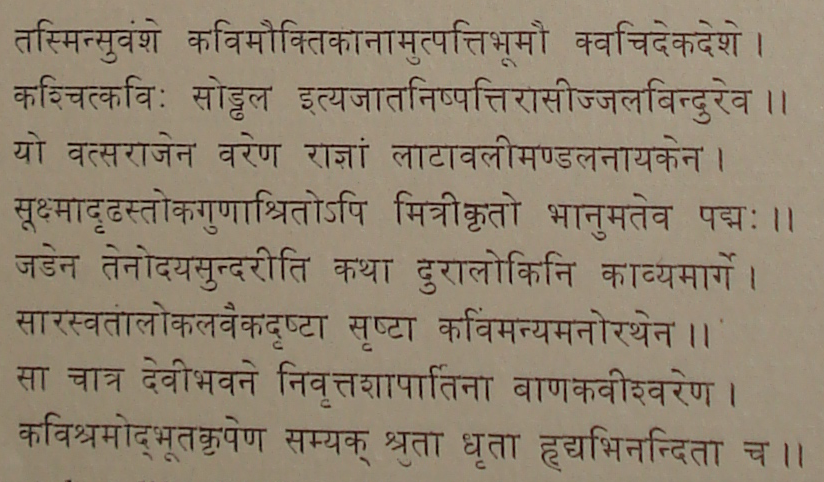|
The Indian Analyst
|
North Indian Inscriptions |
LITERATURE
.. They all then flew back to Pratishṭhāna in an aeroplane into which a Rākshasa had transformed himself. The king Malayavāhana married Udayasundarī and gave Tārāvalī in marriage to prince Kumārakesari.â .. After reading the story of Udayasundarī, Sōḍḍhala again tied the book in the piece of cloth. Then Tālaka praised the work, pointing out its excellences. Sōḍḍhala felt greatly surprised and inquired who they were and how they came to be there in the form of statues. Then Tālaka said, “This is Bāṇa, the Kavīndra-tilaka (ornament of great poets), the worldfamous author of the Kādambarī and the Harshacharita, and I am an humble Dēvarshi (divine sage) named Tālaka. Once I composed a verse in praise of Brahmā and recited it in the assembly of Sarasvatī, where under the presidentship of Bāṇa several great poets like Kālidāsa, kings like Vikramāditya, Śrī-Harsha, Muñja, and Bhōja, and Sāmantas like Vākpatirāja, Māyurāja and Viśākhadēva were engaged in poetic discussions. They all praised my composition, but Bāṇa pointed out the fault of harsh letters in it.[1] So I cursed him that he would have to remain as a stone statue for some time in a temple of Sarasvatī. There was then a great commotion there. At the request of the poets assembled there, I revoked the curse by saying that it would come to an end when he would listen to the Udayasundarīkathā of Sōḍḍhala. Goddess Sarasvatī got enraged when she saw that her favourite poet Bāṇa was thus cursed and gave me also a similar curse, but, later, on my entreating her to revoke it, she said that I would remain in Bāṇa’s company and would be restored to my original form along with him. Since then we both have been staying here. At night the sylvan deity of this place arranges to provide us with a divine light.” Bāṇa then highly praised Sōḍḍhala’s work. He said to him, “You have attained the position of Kavīndra (Great Poet).” They both then bowed to Sarasvatī and left for heaven.
.. Soḍḍhala passed the night in that mattavāraṇa, using the book as a pillow. In a dream at night he noticed that his name was written in a genealogy of poets commencing from Vālmīki. In the morning he obtained the instruments of engraving from his attendants and incised a kavipraśasti (eulogy of poets) on the emerald wall of the temple. It commenced with a maṅgala-ślōka in praise of Śiva, and then had verses in eulogy of great poets of the past like Vālmīki, Vyāsa, Guṇḍhya, Bhartṛimēṇṭha, Kālidāsa, Bāṇa, Bhavabhūti, Vākpatirāja, Abhinanda, Yāyāvara and Kumāradāsa. Thereafter, he inscribed the following verses about himself:[2]
.. (In that good bamboo-like family which has produced excellent pearl-like poets, there was born in a certain place a poet named Sōḍḍhala like a drop of water that has not yet attained the shape of a pearl.
..
Vatsarāja, the best of kings and the lord of the Lāṭa country, regarded him as a friend,
[1] The verse was as follows: व्रह्मंस्त्वां स्तौमि तं यस्य पुष्पलिड्भिः प्रलक्षितम्। पाण्ड्वाभं वल्गु सुष्ट्वब्जं जन्म धिष्ण्यं च विष्टरम्॥
This contains harsh letters in some words and there is the fault of śrutikaṭutva.
|
||||||||||||||||||||||||||||||||||||||||||||||||||||||||||||||||||||||||||||||||||||||||||||||||||||||||||||||||||||||
| > |
|
>
|








